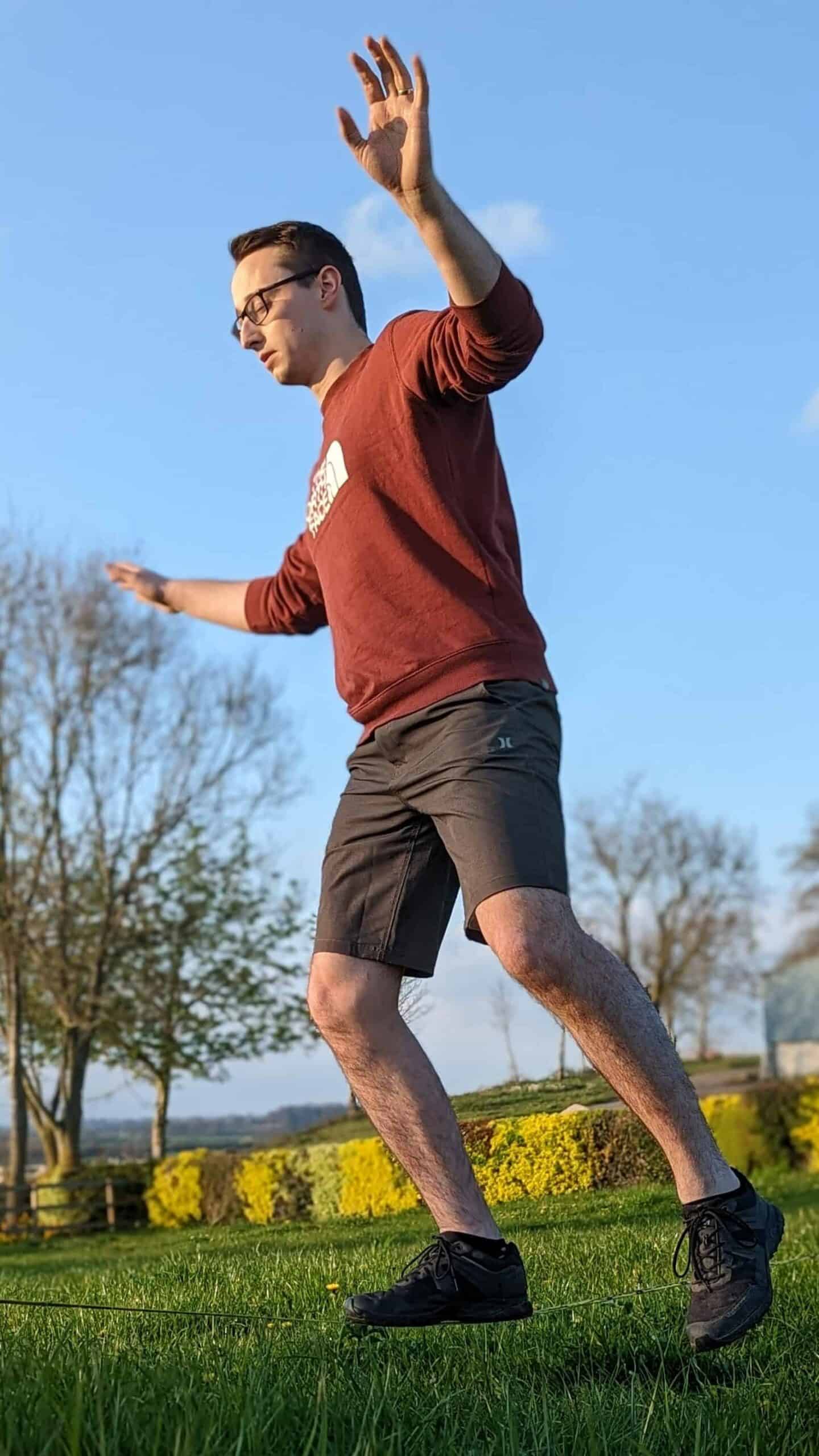Slacklining is a unique and fun-filled physical activity that has gained popularity in recent years. It involves walking, balancing or doing tricks on a thin and flexible piece of webbing anchored between two points. For more info about the sport check out my article that explores where the sport started and how it has developed with multiple disciplines now available.
Slacklining is not only a fun and challenging activity, but it also has many physical benefits. In this article, we will explore some of the physical benefits of slacklining. Seek your doctors advice before starting any new sport.
- Enhanced mental focus
- Reduced stress
- Improved knee strength & stability
- Improved balance and coordination
- Improved core strength
- Improved posture
- Increased flexibility
Enhanced Mental Focus
Slacklining requires a high level of concentration and focus to maintain balance and stability on the slackline. When you’re slacklining, you need to be fully present and mindful of your body’s movements and the environment around you. This level of mental engagement can help to improve cognitive skills, such as attention, concentration, and proprioception (awareness of body position in space), which can have benefits beyond just slacklining.
Improved mental focus can transfer to other areas of life, such as work or daily activities, where concentration and attention are needed. Additionally, the meditative quality of slacklining, with its rhythmic and repetitive movements, can also help to reduce stress and promote relaxation. This can contribute to overall mental well-being and improved mental health.

Reduced Stress
Slacklining can be a form of outdoor physical activity that provides a break from the stresses of daily life. Spending time in nature, breathing in fresh air, and being physically active can help to reduce stress levels. The concentration and mindfulness required during slacklining can also help to shift focus away from stressors and promote a sense of calm and relaxation.
Physical activity, such as slacklining, has been shown to release endorphins, which are natural chemicals in the brain that help to improve mood and reduce stress. Regular physical activity has also been linked to improved mental health, including reduced symptoms of anxiety and depression. Therefore, incorporating slacklining into your routine can be a beneficial way to reduce stress, improve mental well-being, and promote overall health.
Knee Strength & Stability
Slacklining can be good for your knees if done correctly and with proper form. The activity can help to strengthen the muscles around the knee joint, including the quadriceps and hamstrings, which can help to support and stabilize the knee. Additionally, slacklining can help to improve balance and coordination, which can help to prevent falls and knee injuries. Slacklining has also been shown to be useful for lower limb rehabilitation as you get higher levels of activation at lower levels of exertion.
However, it’s important to note that slacklining can also put stress on the knees, especially if the activity is not performed correctly or if there is a pre-existing knee injury. For example, jumping or landing on the slackline can put a lot of stress on the knee joint. It’s also important to ensure that the slackline is set up correctly and at the appropriate tension to avoid any unnecessary stress on the knees.
If you have a pre-existing knee injury or condition, such as arthritis, it’s important to speak with your doctor or physical therapist before starting slacklining or any other new physical activity. They can provide guidance on whether slacklining is a safe and appropriate activity for you and can help you develop a plan to prevent any knee injuries or exacerbation of your condition.
In summary, slacklining can be good for your knees if done correctly and with proper form. It can help to strengthen the muscles around the knee joint, improve balance and coordination, and prevent knee injuries. However, it’s important to approach the activity with caution and seek guidance from a healthcare professional if you have any pre-existing knee conditions or concerns.
Improved Balance and Coordination
Slacklining requires constant adjustments to maintain balance, which engages the muscles around the knees, including the quadriceps and hamstrings. As you work to stay upright on the slackline, you’re also strengthening the muscles that support the knee joint, which can improve balance and coordination, ultimately benefiting knee health.

Improved Core Strength
A strong core is essential for maintaining stability and balance, and slacklining engages the core muscles as they work to stabilize the body on the slackline. This includes the muscles around the abdomen, lower back, and hips, which can contribute to better overall stability and coordination.
Improved posture
Good posture is important for overall musculoskeletal health, and slacklining requires maintaining an upright posture to stay balanced. This can help to improve posture and alignment of the spine, which can have positive effects on overall health.
Increased flexibility
Slacklining involves a range of movements, such as twisting, turning, and bending, which can help to improve joint mobility and flexibility. This can be beneficial for overall movement and reduce the risk of stiffness or strain.

Conclusion
In summary, slacklining not only offers physical benefits, but it also has positive effects on mental health. It enhances mental focus, concentration, and mindfulness, which can have benefits beyond the slackline and can be applied to other areas of life. Additionally, slacklining can reduce stress levels, promote relaxation, and improve overall mental well-being. So, while slacklining is a fun and challenging physical activity, it also provides mental health benefits that contribute to a holistic approach to well-being.
